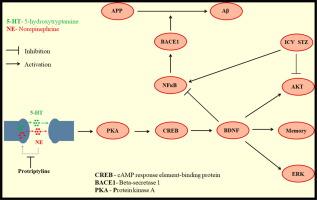Brain Research ( IF 2.9 ) Pub Date : 2021-01-07 , DOI: 10.1016/j.brainres.2020.147261 Virendra Tiwari 1 , Akanksha Mishra 2 , Sonu Singh 3 , Sandeep Kumar Mishra 4 , Kiran Kumari Sahu 5 , Parul 5 , Mahesh J Kulkarni 6 , Rakesh Shukla 4 , Shubha Shukla 1

|
Antidepressants are well known to exert their role via upregulation of brain derived neurotrophic factor (BDNF). BDNF has been reported to exerts its neuroprotective effect in rodent and primate models as well as in patients of Alzheimer's disease (AD). The aim of our study was to evaluate the effect of protriptyline (PRT), a tricyclic antidepressant, in streptozotocin (STZ)- induced rat model of AD. Total 10 µl of STZ was injected into each ventricle (1 mg/kg). PRT (10 mg/kg, i.p.) treatment was started 3-day post STZ administration and continued till 21 days. We found that STZ treatment significantly increased pTau, Aβ42 and BACE-1 expression, oxidative stress and neurodegeneration in hippocampus and cortex of adult rats. STZ induced impairment in spatial learning and retention memory was associated with increased NFκB and reduced CREB and BDNF expression in cortex and hippocampus. Interestingly, PRT treatment significantly reduced pTau, Aβ42 and BACE-1 levels, neurodegeneration, oxidative stress and glial activation, contributing to the improved spatial learning and retention memory in STZ treated rats. Moreover, PRT treatment significantly improved p-ERK/ERK ratio and enhanced BDNF and CREB levels by reducing NFκB and GFAP expression in STZ treated rats. Our data suggest that impaired NFκB and CREB signaling potentially contribute in AD pathogenesis by elevating oxidative stress and neuroinflammation mediated neurodegeneration. Our study has established protriptyline as a multi target molecule in pre-clinical model of AD and further investigations on PRT like molecules could pave way for further development of effective new treatments in neurodegenerative disorders.
中文翻译:

Protriptyline通过调节链脲佐菌素诱导的阿尔茨海默病大鼠模型中的NFκB-BDNF/CREB信号轴来改善空间记忆并减少氧化损伤
众所周知,抗抑郁药通过上调脑源性神经营养因子 (BDNF) 发挥作用。据报道,BDNF 在啮齿动物和灵长类动物模型以及阿尔茨海默病 (AD) 患者中发挥其神经保护作用。我们研究的目的是评估普罗替林 (PRT),一种三环类抗抑郁药,在链脲佐菌素 (STZ) 诱导的 AD 大鼠模型中的作用。总共 10 µl STZ 注射到每个心室 (1 mg/kg)。PRT (10 mg/kg, ip) 治疗在 STZ 给药后 3 天开始并持续到 21 天。我们发现 STZ 治疗显着增加了成年大鼠海马和皮层的 pTau、Aβ42 和 BACE-1 表达、氧化应激和神经变性。STZ 诱导的空间学习和保留记忆受损与 NFκB 增加以及皮质和海马中 CREB 和 BDNF 表达降低有关。有趣的是,PRT 治疗显着降低了 pTau、Aβ42 和 BACE-1 水平、神经变性、氧化应激和神经胶质激活,有助于改善 STZ 治疗大鼠的空间学习和保留记忆。此外,PRT 治疗通过降低 STZ 治疗大鼠的 NFκB 和 GFAP 表达,显着改善了 p-ERK/ERK 比率并增强了 BDNF 和 CREB 水平。我们的数据表明,受损的 NFκB 和 CREB 信号可能通过升高氧化应激和神经炎症介导的神经变性而参与 AD 发病机制。



























 京公网安备 11010802027423号
京公网安备 11010802027423号